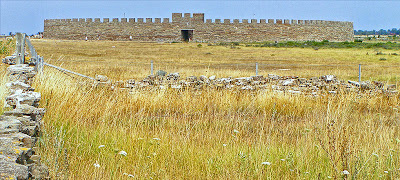 |
| An archaeologist works to uncover one of the skeletons found lying within the 5th-century fort on the Swedish island of Öland [Credit: Lund University] |
During the Migration Period in Scandinavia it was customary to burn the dead, and very few uncremated remains have previously been recovered. The archaeological site therefore offers important clues about the period, and five bodies have been discovered in one house alone. Human bones have been found in other parts of the fort, making it highly likely that many more bodies are yet to be dug out.
 |
| The excavated site of Sandby was similar to the reconstructed Eketorp borg at Stora alvaret, Öland, Sweden [Credit: WikiCommons] |
Only a few houses have been excavated so far, and the archaeologists believe that hundreds of people could have lived within the walls of the fort. Lund University archaeologist Nicoló Dell’Unto is creating 3D-models of the site, using groundbreaking 3D technology, in order to reconstruct how the crime scene unfolded, and to get a more complex overview of the site.
“Using 3D-modeling gives us the unprecedented opportunity to see all the bodies simultaneously, even though the skeletons were removed one by one”, says Nicoló Dell’Unto.
Why the fort has been left untouched for 1,500 years remains a mystery. One theory is that the location became taboo after the massacre, but the archaeologists hope the answer will become clearer with further excavations.
“It’s a day in life of the Migration Period, and that’s completely unique. We have nothing to compare it to”, concludes Helene Wilhelmson.

No comments:
Post a Comment